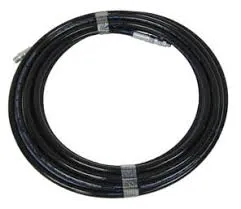what causes power steering hose to leak
What Causes Power Steering Hose to Leak?
Power steering systems play a critical role in vehicle control and handling, making driving easier and safer. A vital component of this system is the power steering hose, which transports hydraulic fluid from the pump to the steering gear. Over time, these hoses may develop leaks, leading to a host of problems that can compromise the vehicle's steering capabilities. Understanding the causes of power steering hose leaks can help in preventative maintenance and ensuring a safe driving experience.
1. Wear and Tear
One of the most common reasons for power steering hose leaks is natural wear and tear. Power steering hoses are typically made from rubber or synthetic materials that can degrade over time due to constant exposure to heat, cold, and various environmental conditions. Extreme temperatures can cause the hose material to become brittle, leading to cracks that can result in leaks. Additionally, frequent fluctuations in pressure and movement as the steering system operates can wear the hose material, causing it to fray or crack.
2. Chemical Exposure
Power steering fluid is formulated to withstand certain chemicals, but exposure to other substances can weaken the hose material. Leaking oil or coolant, road contaminants, or exposure to harsh cleaning chemicals can degrade the rubber, leading to leaks. This is particularly a concern for older vehicles where hoses may have already been subjected to years of wear. It's essential to regularly inspect hoses for signs of chemical damage and replace them when necessary.
what causes power steering hose to leak

When power steering hoses are installed incorrectly, it can lead to unnecessary stress and strain on the hose material. Hoses that are too tightly bent or twisted may experience additional pressure points, which can eventually lead to failures and leaks. This problem often arises during repairs or replacements when mechanics may not follow proper installation procedures. Ensuring that any replacements are installed according to manufacturer specifications is crucial in preventing future leaks.
4. Corrosion of Fittings and Connectors
The connectors and fittings that link power steering hoses to the pump and steering gear can also be susceptible to corrosion. Over time, moisture and contaminants can accumulate, causing rust and degradation of these metal components. Corroded fittings may create gaps that lead to hydraulic fluid leaking out. Regular inspections of these components, especially in older vehicles, can help identify and address corrosion issues before they lead to significant leaks.
5. High Pressure in Steering System
Another potential cause of power steering hose leaks is excessive pressure in the system, often due to a malfunctioning power steering pump or a blockage in the return line. When the pressure exceeds the hose's capacity, it can cause the hoses to burst or leak, resulting in a loss of fluid. Regular maintenance and checks of the complete power steering system can help prevent pressure-related issues.
Conclusion
Power steering hose leaks can significantly impact the safety and performance of a vehicle. Understanding the various causes of these leaks—like wear and tear, chemical exposure, improper installation, corrosion, and high pressure—can assist vehicle owners and mechanics in maintaining a reliable steering system. Regular inspections and timely replacements of worn components are essential in ensuring a safe and enjoyable driving experience. Keeping an eye on the power steering system can save money in the long run and help avoid more severe problems down the road.
-
Ultimate Spiral Protection for Hoses & CablesNewsJun.26,2025
-
The Ultimate Quick-Connect Solutions for Every NeedNewsJun.26,2025
-
SAE J1401 Brake Hose: Reliable Choice for Safe BrakingNewsJun.26,2025
-
Reliable J2064 A/C Hoses for Real-World Cooling NeedsNewsJun.26,2025
-
Heavy-Duty Sewer Jetting Hoses Built to LastNewsJun.26,2025
-
Fix Power Steering Tube Leaks Fast – Durable & Affordable SolutionNewsJun.26,2025

